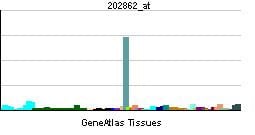Entrez 2184 | Ensembl ENSG00000103876 | |
 | ||
Aliases FAH, Fumarylacetoacetase External IDs MGI: 95482 HomoloGene: 110 GeneCards: FAH | ||
Fumarylacetoacetase is an enzyme that in humans is encoded by the FAH gene located on chromosome 15. The FAH gene is thought to be involved in the catabolism of the amino acid phenylalanine in human.
Contents
Structure
The FAH gene is located on the chromosome 15q25.1 region and contains 14 exons. It encodes a protein that is 46kDa in height. Multiple isoforms of the protein have been discovered that arose from alternative splicing. The gene is mainly expressed in the liver and the kidney.
Function
The fumarylacetoacetate hydrolase enzyme catalyzes the hydrolysis of 4-fumarylacetoacetate into fumarate and acetoacetate. This gene encodes the last enzyme in the subpathway that synthesizes acetoacetate and fumarate from L-phenylalanine, which is part of a subpathway involved in phenylalanine degradation, part of the overall biochemical process of amino acid degradation. Other proteins that are involved in the phenylalanine degradation subpathway include phenylalanine-4-hydroxylase (PAH), tyrosine aminotransferase (TAT), 4-hydroxyphenylpyruvate dioxygenase (HPD), homogentisate 1,2-dioxygenase (HGD), maleylacetoacetate isomerase (GSTZ1), fumarylacetoacetase (FAH)
The protein has a number of conserved co-factor binding sites and probably requires Mg2+ and Ca2+ to function.
Clinical Significance
Mutations in the FAH gene cause type I tyrosinemia, an inborn error of metabolism that is characterized by increased tyrosine levels in the blood and urine of patients.
Patients usually develop features including hepatic necrosis and renal tubular injury due to toxic accumulation of tyrosine and phenylalanine and may be treated by tyrosine and phenylalanine dietary restriction and liver transplantation. The disease is also known to cause hypertrophic cardiomyopathy in affected children.
